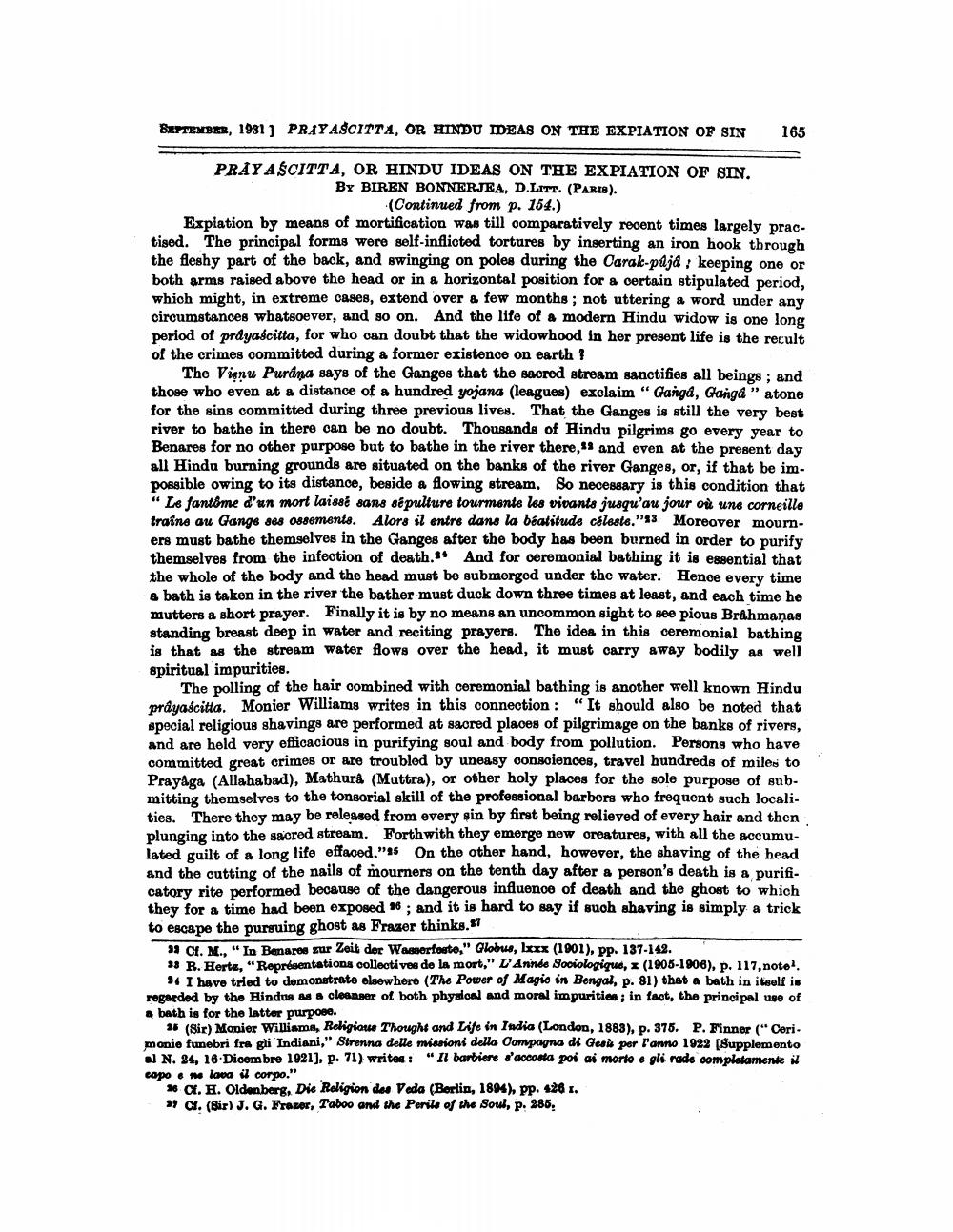________________
SEPTEMBER, 1931] PRAYAŠCITTA, OR HINDU IDEAS ON THE EXPIATION OF SIN
PRAY ASCITTA, OR HINDU IDEAS ON THE EXPIATION OF SIN. BY BIREN BONNERJEA, D.LITT. (PARIS). (Continued from p. 154.)
Expiation by means of mortification was till comparatively recent times largely practised. The principal forms were self-inflicted tortures by inserting an iron hook through the fleshy part of the back, and swinging on poles during the Carak-pajd keeping one or both arms raised above the head or in a horizontal position for a certain stipulated period, which might, in extreme cases, extend over a few months; not uttering a word under any circumstances whatsoever, and so on. And the life of a modern Hindu widow is one long period of prayaścitta, for who can doubt that the widowhood in her present life is the recult of the crimes committed during a former existence on earth?
165
The Visnu Purana says of the Ganges that the sacred stream sanctifies all beings; and those who even at a distance of a hundred yojana (leagues) exclaim "Ganga, Ganga" atone for the sins committed during three previous lives. That the Ganges is still the very best river to bathe in there can be no doubt. Thousands of Hindu pilgrims go every year to Benares for no other purpose but to bathe in the river there, and even at the present day all Hindu burning grounds are situated on the banks of the river Ganges, or, if that be impossible owing to its distance, beside a flowing stream. So necessary is this condition that "Le fantôme d'un mort laissé sans sépulture tourmente les vivants jusqu'au jour où une corneille traîne au Gange ses ossements. Alors il entre dans la béatitude céleste."3 Moreover mourners must bathe themselves in the Ganges after the body has been burned in order to purify themselves from the infection of death. And for ceremonial bathing it is essential that the whole of the body and the head must be submerged under the water. Hence every time a bath is taken in the river the bather must duck down three times at least, and each time he mutters a short prayer. Finally it is by no means an uncommon sight to see pious Brahmanas standing breast deep in water and reciting prayers. The idea in this ceremonial bathing is that as the stream water flows over the head, it must carry away bodily as well spiritual impurities.
The polling of the hair combined with ceremonial bathing is another well known Hindu prayaścitia. Monier Williams writes in this connection: "It should also be noted that special religious shavings are performed at sacred places of pilgrimage on the banks of rivers, and are held very efficacious in purifying soul and body from pollution. Persons who have committed great crimes or are troubled by uneasy consciences, travel hundreds of miles to Prayaga (Allahabad), Mathura (Muttra), or other holy places for the sole purpose of submitting themselves to the tonsorial skill of the professional barbers who frequent such localities. There they may be released from every sin by first being relieved of every hair and then plunging into the sacred stream. Forthwith they emerge new oreatures, with all the accumulated guilt of a long life effaced."5 On the other hand, however, the shaving of the head and the cutting of the nails of mourners on the tenth day after a person's death is a purificatory rite performed because of the dangerous influence of death and the ghost to which they for a time had been exposed 16; and it is hard to say if such shaving is simply a trick to escape the pursuing ghost as Frazer thinks.37
33 Cf. M., "In Benares zur Zeit der Wasserfeste," Globus, lxxx (1901), pp. 137-142.
33 R. Hertz, "Représentations collectives de la mort," L'Année Sociologique, x (1905-1906), p. 117,note1. 34 I have tried to demonstrate elsewhere (The Power of Magic in Bengal, p. 81) that a bath in itself is regarded by the Hindus as a cleanser of both physical and moral impurities; in fact, the principal use of a bath is for the latter purpose.
26 (Sir) Monier Williams, Religious Thought and Life in India (London, 1883), p. 375. P. Finner ("Cerimonie funebri fra gli Indiani," Strenna delle missioni della Compagna di Gesù per l'anno 1922 [Supplemento al N. 24, 16 Dicembre 1921], p. 71) writes: "Il barbiere s'accosta poi ai morto e gli rade completamente il capo e ne lava il corpo."
16 Cf. H. Oldenberg, Die Religion des Veda (Berlin, 1894), pp. 426 1. 37 Cf. (Bir) J. G. Frazer, Taboo and the Perils of the Soul, p. 285.




